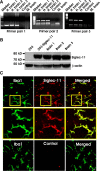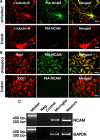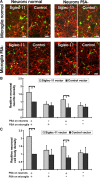Alleviation of neurotoxicity by microglial human Siglec-11
- PMID: 20203208
- PMCID: PMC6634112
- DOI: 10.1523/JNEUROSCI.3940-09.2010
Alleviation of neurotoxicity by microglial human Siglec-11
Abstract
Sialic acid-binding Ig superfamily lectins (Siglecs) are members of the Ig superfamily that recognize sialic acid residues of glycoproteins. Siglec-11 is a recently identified human-specific CD33-related Siglec that binds to alpha2,8-linked polysialic acids and is expressed on microglia, the brain resident innate immune cells. Polysialylated neuronal cell adhesion molecule (PSA-NCAM) is a putative ligand of Siglec-11. We observed gene transcription and protein expression of Siglec-11 splice variant 2 in human brain tissue samples by RT-PCR and Western blot analysis. Siglec-11 was detected on microglia in human brain tissue by immunohistochemistry. Human Siglec-11 splice variant 2 was ectopically expressed by a lentiviral vector system in cultured murine microglial cells. Stimulation of Siglec-11 by cross-linking suppressed the lipopolysaccharides (LPS)-induced gene transcription of the proinflammatory mediators interleukin-1beta and nitric oxide synthase-2 in microglia. Furthermore, phagocytosis of apoptotic neuronal material was reduced in Siglec-11 transduced microglia. Expression of PSA-NCAM was detected on microglia and neurons by immunohistochemistry and RT-PCR. Coculture of microglia transduced with Siglec-11 and neurons demonstrated neuroprotective function of Siglec-11. The neuroprotective effect of Siglec-11 was dependent on polysialic acid (PSA) residues on neurons, but independent on PSA on microglia. Thus, data demonstrate that human Siglec-11 ectopically expressed on murine microglia interacts with PSA on neurons, reduces LPS-induced gene transcription of proinflammatory mediators, impairs phagocytosis and alleviates microglial neurotoxicity.
Conflict of interest statement
The authors declare no competing financial interests.
Figures




Similar articles
-
Microglial CD33-related Siglec-E inhibits neurotoxicity by preventing the phagocytosis-associated oxidative burst.J Neurosci. 2013 Nov 13;33(46):18270-6. doi: 10.1523/JNEUROSCI.2211-13.2013. J Neurosci. 2013. PMID: 24227736 Free PMC article.
-
Sensing the neuronal glycocalyx by glial sialic acid binding immunoglobulin-like lectins.Neuroscience. 2014 Sep 5;275:113-24. doi: 10.1016/j.neuroscience.2014.05.061. Epub 2014 Jun 9. Neuroscience. 2014. PMID: 24924144 Review.
-
Proteomic analysis of microglial contribution to mouse strain-dependent dopaminergic neurotoxicity.Glia. 2006 Apr 15;53(6):567-82. doi: 10.1002/glia.20294. Glia. 2006. PMID: 16419087
-
Excitatory amino acid transporter expression by astrocytes is neuroprotective against microglial excitotoxicity.Brain Res. 2008 May 19;1210:11-9. doi: 10.1016/j.brainres.2008.03.012. Epub 2008 Mar 20. Brain Res. 2008. PMID: 18410911
-
Siglec functions of microglia.Glycobiology. 2014 Sep;24(9):794-9. doi: 10.1093/glycob/cwu044. Epub 2014 May 15. Glycobiology. 2014. PMID: 24833613 Review.
Cited by
-
Inflammation, Iron, Energy Failure, and Oxidative Stress in the Pathogenesis of Multiple Sclerosis.Oxid Med Cell Longev. 2015;2015:725370. doi: 10.1155/2015/725370. Epub 2015 May 27. Oxid Med Cell Longev. 2015. PMID: 26106458 Free PMC article. Review.
-
Evolution of siglec-11 and siglec-16 genes in hominins.Mol Biol Evol. 2012 Aug;29(8):2073-86. doi: 10.1093/molbev/mss077. Epub 2012 Mar 1. Mol Biol Evol. 2012. PMID: 22383531 Free PMC article.
-
The hypothesis on function of glycosphingolipids and ABO blood groups revisited.Neurochem Res. 2012 Jun;37(6):1170-84. doi: 10.1007/s11064-012-0734-0. Epub 2012 Mar 11. Neurochem Res. 2012. PMID: 22407244 Review.
-
Control of Innate Immunity by Sialic Acids in the Nervous Tissue.Int J Mol Sci. 2020 Jul 31;21(15):5494. doi: 10.3390/ijms21155494. Int J Mol Sci. 2020. PMID: 32752058 Free PMC article. Review.
-
Friend or Foe? Resident Microglia vs Bone Marrow-Derived Microglia and Their Roles in the Retinal Degeneration.Mol Neurobiol. 2017 Aug;54(6):4094-4112. doi: 10.1007/s12035-016-9960-9. Epub 2016 Jun 18. Mol Neurobiol. 2017. PMID: 27318678 Review.
References
-
- Angata T, Kerr SC, Greaves DR, Varki NM, Crocker PR, Varki A. Cloning and characterization of human Siglec-11. A recently evolved signaling that can interact with SHP-1 and SHP-2 and is expressed by tissue macrophages, including brain microglia. J Biol Chem. 2002;277:24466–24474. - PubMed
-
- Angata T, Hayakawa T, Yamanaka M, Varki A, Nakamura M. Discovery of Siglec-14, a novel sialic acid receptor undergoing concerted evolution with Siglec-5 in primates. FASEB J. 2006;20:1964–1973. - PubMed
-
- Angata T, Tabuchi Y, Nakamura K, Nakamura M. Siglec-15: an immune system Siglec conserved throughout vertebrate evolution. Glycobiology. 2007;17:838–846. - PubMed
-
- Avril T, Freeman SD, Attrill H, Clarke RG, Crocker PR. Siglec-5 (CD170) can mediate inhibitory signaling in the absence of immunoreceptor tyrosine-based inhibitory motif phosphorylation. J Biol Chem. 2005;280:19843–19851. - PubMed
-
- Bally-Cuif L, Goridis C, Santoni MJ. The mouse NCAM gene displays a biphasic expression pattern during neural tube development. Development. 1993;117:543–552. - PubMed
Publication types
MeSH terms
Substances
LinkOut - more resources
Full Text Sources
Other Literature Sources
Medical
Molecular Biology Databases
Research Materials
Miscellaneous
